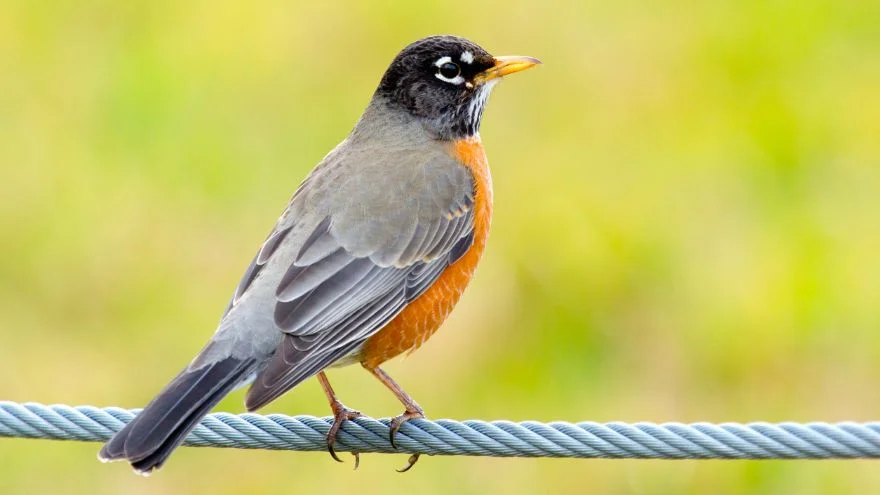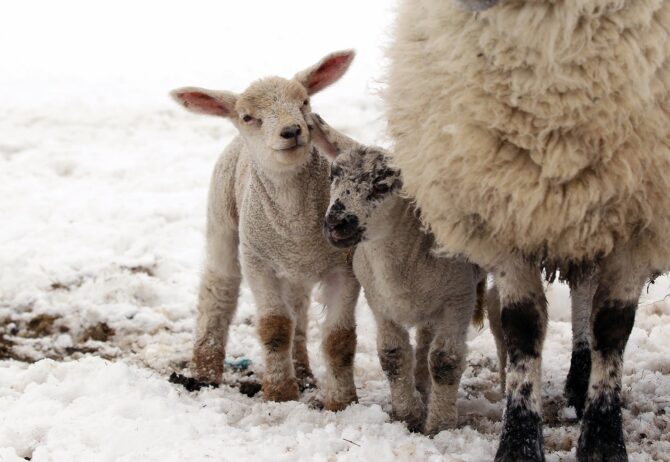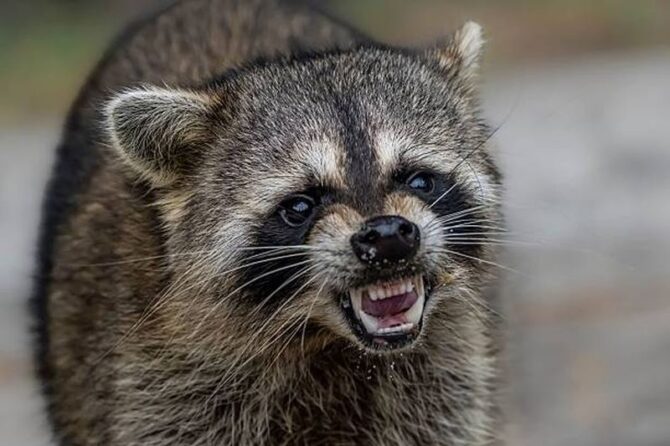Some species of birds that look like robins are rose-breasted grosbeak, spotted towhee, American redstart, orchard and Baltimore oriole, and many others.
Robins are popular birds, but the American robin (Turdus migratorius) is most likely the most popular of all its species. The American robins are relatively large songbirds with large rounded bodies and long tails.
However, these characteristics are not peculiar to them alone, as several bird species share glaring similarities with robins.
They live in the continent’s deciduous woodland, shrub lands, pine forests, fields, yards, gardens, pastures, and golf courses.
This article lists 15 birds that look similar to robins but aren’t. They share physical features and characteristics similar to robins, along with their basic facts and descriptions.
Birds That Look Like Robins But Aren’t
1. Rose-breasted Grosbeak
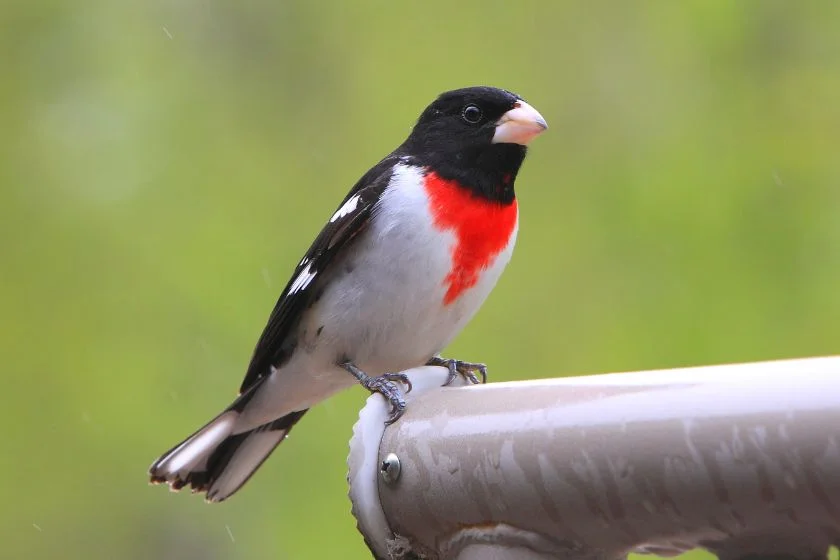
- Scientific Name: Pheucticus ludovicianus
- Size: 7.1–8.3 in (length), 1.4–1.7 oz (weight), 11.4–13 in (wingspan)
- Habitat: Forest edges, woodlands
- Range: Canada, United States
These rose-breasted bird species are from the family of Cardinalidae; they have broad chests and sturdy triangular bills.
The male of this bird is identified with a black head, tails, wings with white beaks, and a belly with rose-red breasts, identical to robins. Female rose-breasted grosbeaks are brown with bold white stripes over their eyes.
These bird species have a distinct sound like robins with increased sonority. They feed on sunflower seeds, safflower seeds, raw peanuts, and insects and fruits, unlike robins that prefer insects over grains and fruits.
2. Spotted Towhee
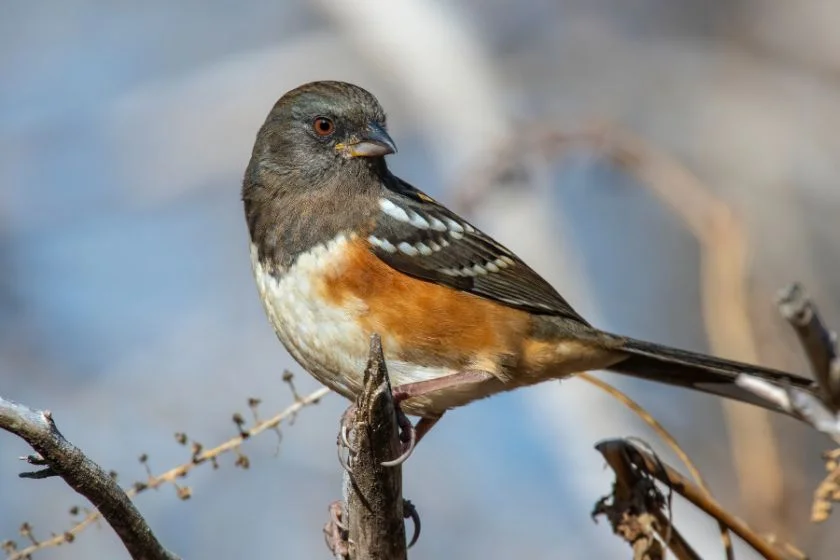
- Scientific Name: Pipilo maculatus
- Size: 6.7–8.3 in (length), 1.2–1.7 oz (weight), 11 in (wingspan)
- Habitat: overgrown field, forest edges, backyard, shrubby habitat
- Range: Canada, United States.
Spotted towhee is from the family of Passerellidae, and they are of similar size and color as robins.
The male spotted towhee has a black upper body, white-spotted back, with a white belly and red flanks. Female species have a similar pattern but are more greyish-brown than black.
The spotted towhee’s diet varies with the season; it loves to feed on berries, seeds, and acorns in the winter and insects like beetles, caterpillars, true bugs, and grasshoppers in summer.
Also, like robins, the spotted towhee enjoys being close to the ground.
3. American Redstart

- Scientific Name: Setophaga ruticilla
- Size: 4.3–5.1 in (length), 0.2–0.3 oz (weight), 6.3–7.5 in (wingspan)
- Habitat: Open wooded habitat, treed habitat
- Range: North America, South America, Florida, Central America
This robin look-alike comes from the family of Parulidae, which are highly active birds. American redstart birds have long tails and flat, wide bills similar to the robin.
The male species are usually black with patches of orange on the wings, sides, and tails and a white belly. Females and young species replace the orange patches with a yellowish-orange or yellow and grey head, tail, and underparts.
American redstarts have black tails, while robins have dark tails with white tips.
These birds prefer feeding on insects such as moths, caterpillars, midges, and beetles, but they also feed on seeds and berries.
4. Orchard Oriole
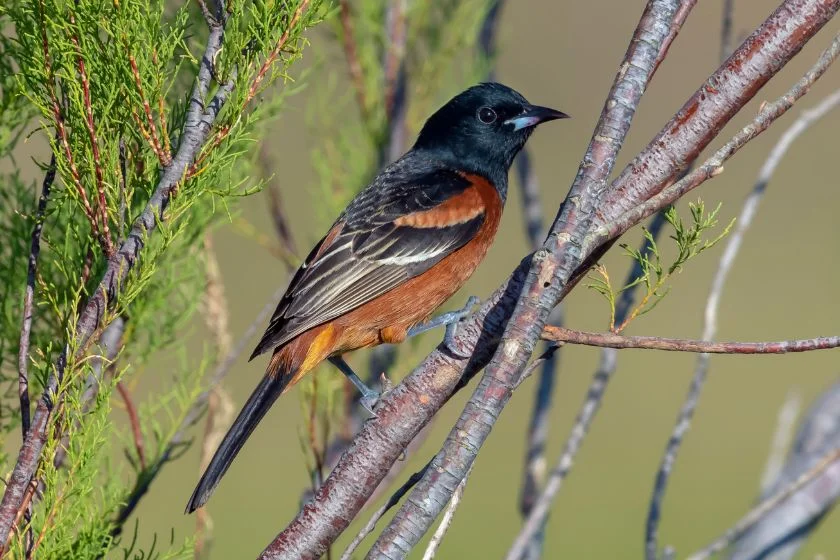
- Scientific Name: Icterus spurius
- Size: 5.9–7.1 in (length), 0.6–1 oz (weight), 9.8 in (wingspan)
- Habitat: orchards, river edges, open woodlands
- Range: Maryland, Eastern United States
The orchard oriole is a member of the Icteridae family. These songbirds are slim with straight, pointed bills and round heads.
The female species are greenish-yellow with white wing bars, while the male species have a black head and throat area. The male orchard oriole also has more detailed similarities with the robin species of birds.
They have a red chestnut patch, similar to a robin, and feed on insects such as beetles, caterpillars, wasps, and fruits like berries and oranges. They drink nectar from flowers and prefer to stay on treetops near the ground.
5. Baltimore Oriole
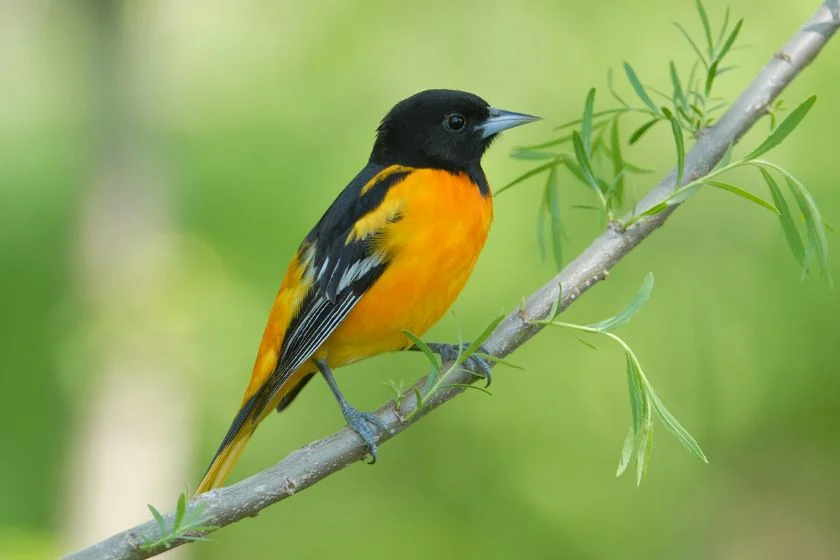
- Scientific Name: Icterus galbula
- Size: 6.5–8 in (length), 1.5 oz (weight), 3.5–4 in (wingspan)
- Habitat: Open woodlands, forest edges
- Range: North America, Central Canada
The Baltimore bird species is also part of the Icteridae family like the Orchard oriole; they’re sweet singers and are often at the tree tops.
The adult males are attractive, with their orange and black heads and white wing bars, while the color of the females ranges from orange to yellow underparts and black heads.
These species feed on insects and fruits but prefer to eat dark-colored fruits. Unlike the robin and other birds that eat fruits, they ignore brightly colored fruits like yellow cherries even if they’re ripe and prefer the reddest of cherries and dark mulberries.
6. Varied Thrush

- Scientific Name: Ixoreus naevius
- Size: 7.5–10.2 in (length), 2.3–3.5 oz (weight), 13.4–15 in(wingspan)
- Habitat: Dense wet forests
- Range: Worldwide
Varied thrush birds are members of the Turdidae family like the American robin but differ in the genus as it belongs to the Ixoreus genus. They’re sturdier birds with rounded and big heads and long legs.
The males of these songbirds have dark bluish-grey backs, burnt orange under, and black breast bands. They have an orange line above the eye which a robin doesn’t have, and black wings with two orange markings, while robin’s wings have white and black markings.
Their female species are also like the males but are more greyish brown.
Various thrush diets vary with season; they feed on nuts and fruits in fall and winter but they prefer to eat insects during summer.
7. Eastern Towhee
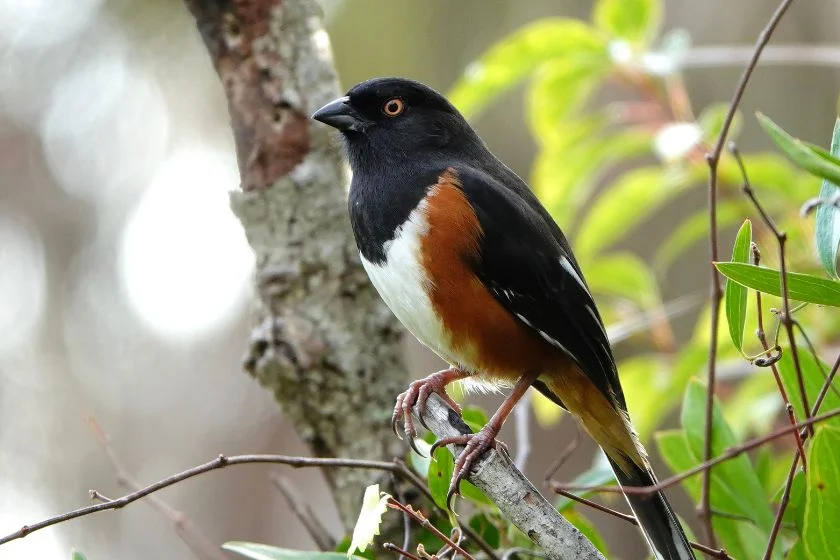
- Scientific Name: Pipilo erythrophthalmus
- Size: 7.25–8 in (length), 1.1–1.9 oz (weight), 10 in (wingspan)
- Habitat: Brushy edges, open woods, undergrowth
- Range: the Eastern United States and Canada
The Eastern towhee is also from the family of Passerellidae, like the spotted towhee.
These birds are large and long-tailed with a white belly, bright rufous sides, and black upper parts; however, the females are more brown than black. They are similar to the spotted towhee but without wing bars and white spots on the back.
The eastern towhee birds are seen on the ground, using their feet to scratch leaves. These bird species’ feeding habits vary with season and region; they eat insects like ants, millipedes, and true bugs in the summer and eat seeds and fruits in winter.
8. Red-winged Blackbird
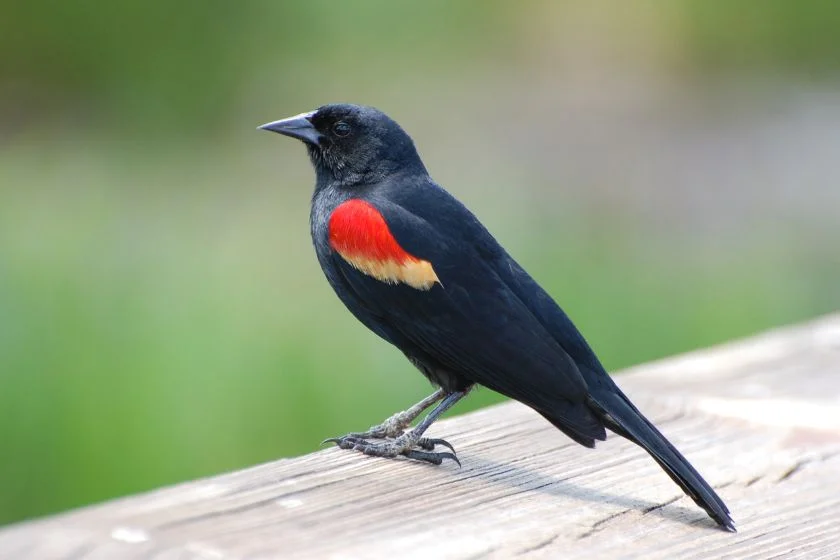
- Scientific Name: Agelaius phoeniceus
- Size: 6.7–9.1 in (length), 1.1–2.7 oz (weight), 12.3–15.8 in (wingspan)
- Habitat: Fresh and saltwater marsh, crop fields, and pastures
- Range: California, Canada
The red-winged blackbird is another member of the Icteridae family that looks like a robin.
They’re one of the most polygamous of all bird species and are attention seekers, especially the male species, which perches on the top of trees, belting out their song throughout the day.
The male birds are shiny black with red and yellow shoulder bands, while the females are colored dark brown and paler around the chest area.
They feed mostly on insects, including butterflies, dragonflies, and damselflies; in winter, they prefer to feed on seeds and grains.
9. Black-headed Grosbeak
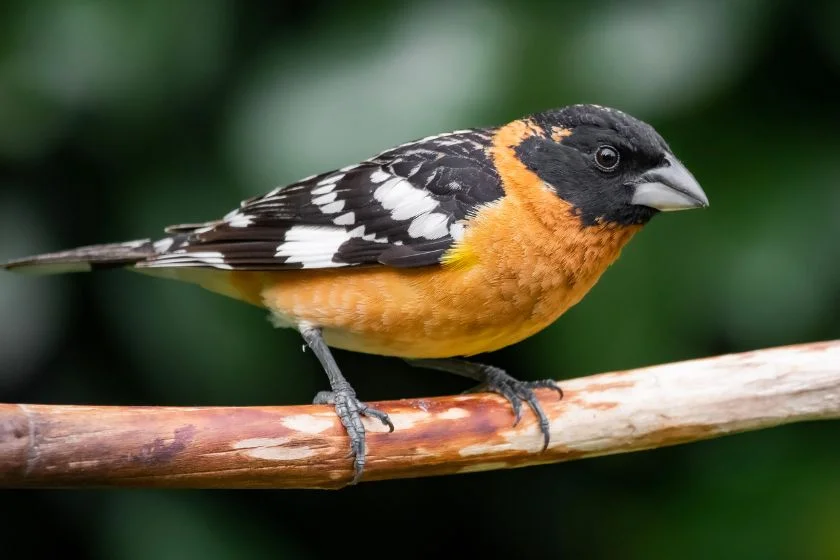
- Scientific Name: Pheucticus melanocephalus
- Size: 7.1–7.5 in (length), 1.2–1.7 oz (weight), 12.6 in (wingspan)
- Habitat: Mixed woodland and mountain forest
- Range: Eastern United States, Northern Mexico
Black-headed grosbeak is a member of the family Cardinalidae with a short tail, large head, and thick, short necks.
They are slender and more compact than the robin, but their coloration and range could be mixed up with a robin bird.
The males of this species have an orange body with a black head and white and black wings, while the females have a brown upper body and orange-colored breasts.
The black-headed grosbeak is a very loud singer, and the males sing in a whistled lilt from the top of trees.
These birds prefer to feed on seeds and fruits, including apples, peaches, berries, and plums.
10. Blackburnian Warbler
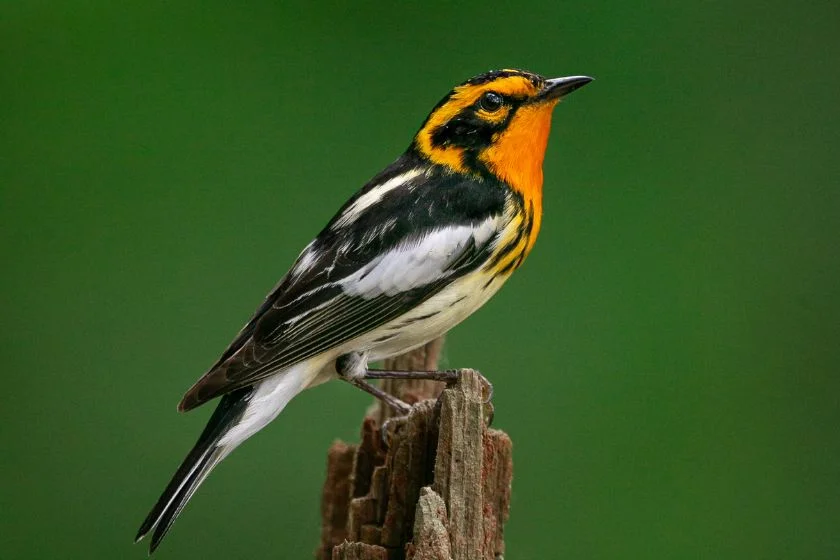
- Scientific Name: Setophaga fusca
- Size: 4.3–4.7 in (length), 0.3–0.4 oz (weight), 7.9–9.1 in (wingspan)
- Habitat: Wooded habitat, mixed forests, conifers
- Range: Northern America, New England, North Carolina
The Blackburnian warbler is a member of the Parulidae family.
The male species are well known for their glowing orange throat, face, breast, black triangular cheek patch, and irregularly shaped white wing patch. Females and younger blackburnian warblers have a distinct yellowish throat.
These medium-sized birds are smaller than robins and have slim bodies and medium-length tails. They are sonorous singers with high-pitched voices and feed on fruits and insects, including spiders.
However, unlike robins, Blackburnian warblers are not frequently seen as they prefer to stay in nests high in the trees.
11. Bullock’s Oriole
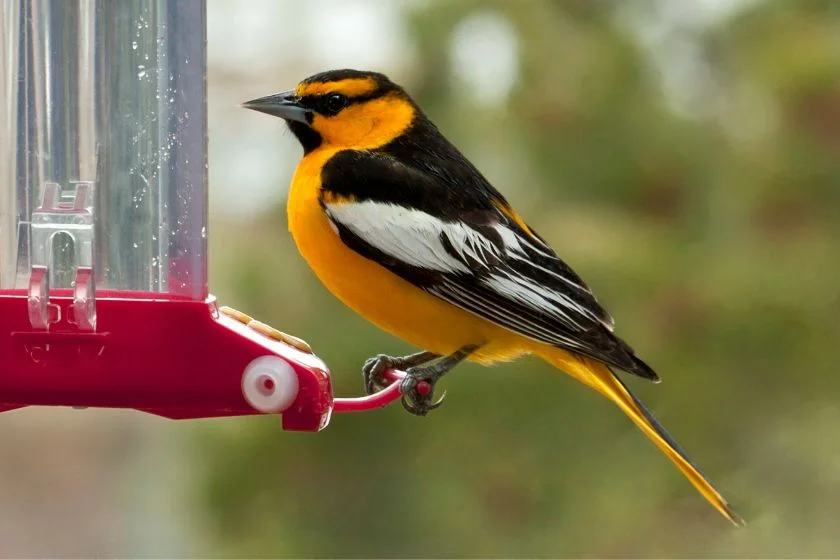
- Scientific Name: Icterus bullocki
- Size: 6.7–7.5 in (length), 1–1.5 oz (weight), 12.2 in (wingspan)
- Habitat: Open woodlands and orchards
- Range: Mexico, Southern Coastal California
A member of the family Icteridae, Bullock’s oriole bird looks like robins but is bigger. They are active and often seen hanging upside down or stretching to reach their prey.
The male species have a black body, white wing patch, and black line over their orange eye. On the other hand, the females and younger species have grey backs and yellowish-orange heads and tails.
These oriole bird species feed on insects, wild grapes, and berries and drink nectar.
12. Common Redstart
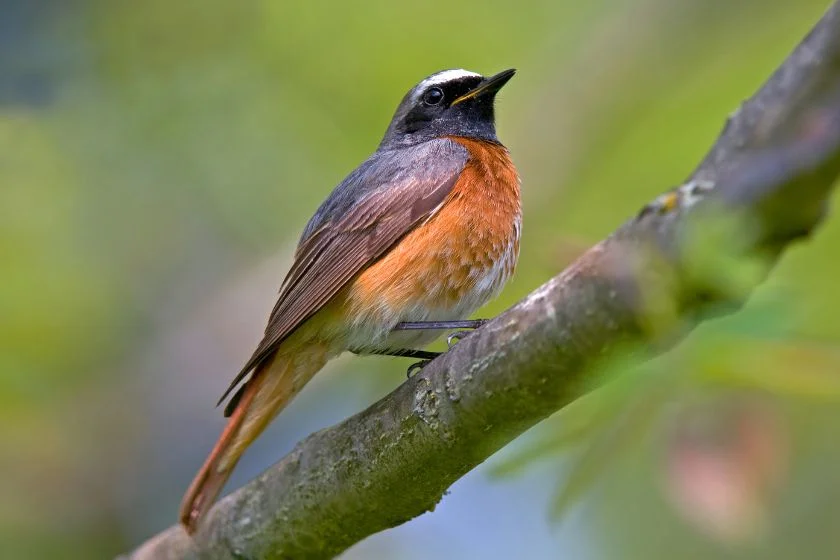
- Scientific Name: Phoenicurus Phoenicurus
- Size: 5.5 in (length), 0.3–0.6 oz (weight), 7.8–9.5 in (wingspan)
- Habitat: woodlands, open forests
- Range: Middle America, Southwest United States
The common redstart, also known as redstart, is from the Muscicapidae family.
The redstart songbird has its male species with a blue-grey back and wings, orange rufous, while their females have duller coloring with a brown body. The males sing sweet two phrases songs, and females don’t usually sing.
They feed on invertebrates, mollusks, berries, and several other fruits.
13. Cedar Waxwing
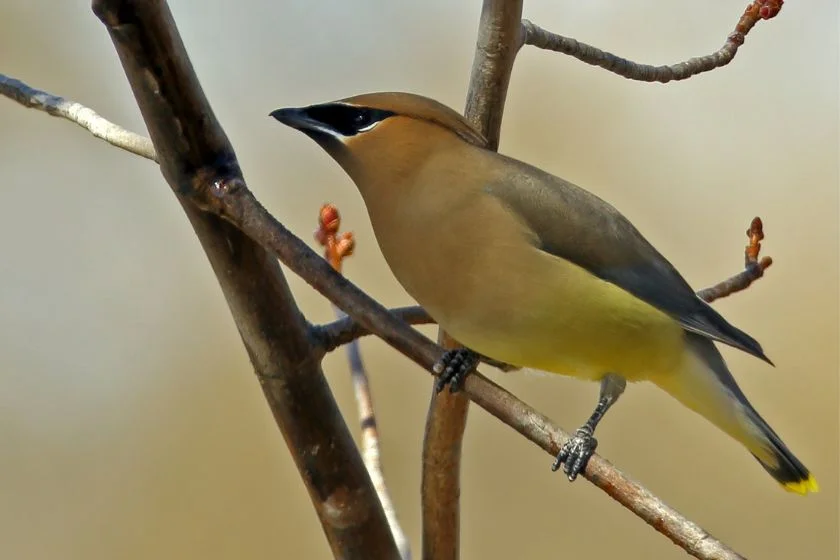
- Scientific Name: Bombycilla cedrorum
- Size: 5.5–6.7 in (length), 1.1 oz (weight), 8.7–11.8 in (wingspan)
- Habitat: Woodlands
- Range: Southeastern United States
The cedar waxwing bird is a member of the family Bombycillidae; they are much similar to the robin and mostly stay close to the ground.
However, unlike the robin, they prefer being in the company of other birds as they’re social birds, and it’s very rare to see just one at a time.
These social birds are medium-sized, sleek birds with broad wings, short necks, and large heads. They have pale brown heads, yellow bellies, and grey wings and feed on mainly berries and insects.
14. Nightingale

- Scientific Name: Luscinia megarhynchos
- Size: 5.5–6.5 in (length), 0.5–0.7 oz (weight), 8–10 in (wingspan)
- Habitat: conifer forests, woodland
- Range: Asia, Europe, Central Africa
Nightingale is a member of the Muscicapidae family; its female species is usually mistaken for a robin, but it’s slightly larger.
These birds aren’t as brightly colored as one would expect with their sonorous voice; they have a plain brown plumage with lighter shade underparts.
The nightingale bird species prefer to nest in hazel trees and feed on nuts, fruits, seeds, and insects.
15. Red-breasted Nuthatch

- Scientific Name: Sitta canadensis
- Size: 4.3 in (length), 0.3–0.5 oz (weight), 7.1–7.9 in (wingspan)
- Habitat: Coniferous woods and mountains
- Range: North America
The red-breasted nuthatch is a small-sized bird and a member of the Sittidae family. It got its name from its distinctive red breast that is similar to that of a robin, but it’s smaller and with a shorter tail.
The male species have a distinct red breast and black head with stripes over the eyes, while the female red-breasted nuthatch has a grey back and white patch in the under area.
These birds usually stay on tree branches feeding on a wide variety of insects, and during winter, they feed on seeds such as sunflower seeds and nuts.
Also See:
30 Purple Birds List (Species With Pictures & Facts)
Conclusion
There are numerous species of birds that look like robins but aren’t; however, you can easily distinguish these birds from the robin due to their slight differences.
To distinguish between these bird species, you must pay extra attention to even the most minor details.
You can tell them apart from their tail length, color, size and wingspan, and even the color patches on their body parts.
Reference: Partners in Flight Databases, Audubon
Featured Image Credit: 4kodiak / Getty Images
